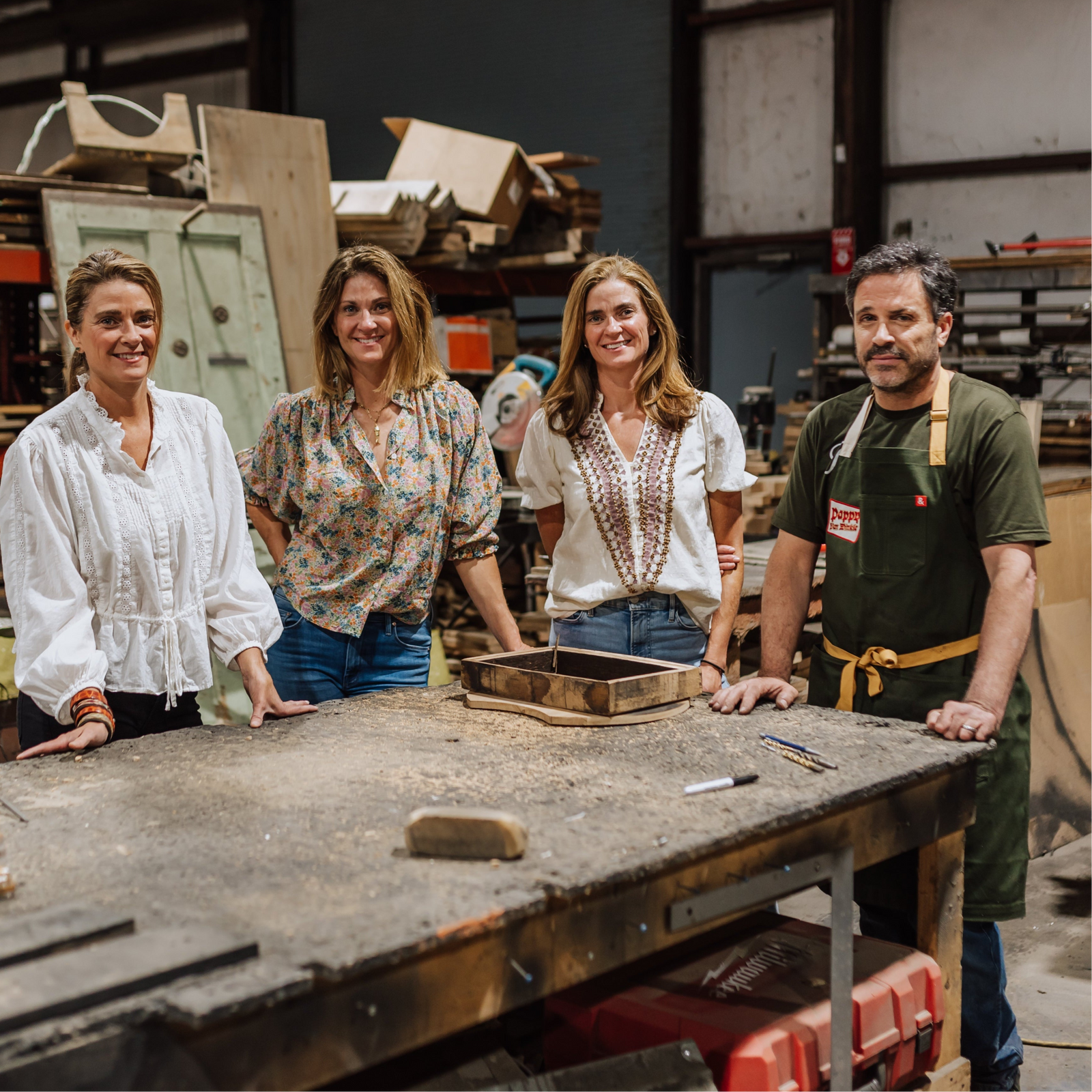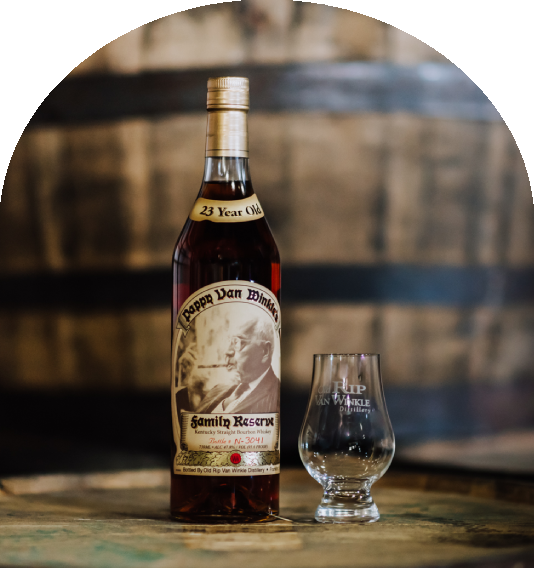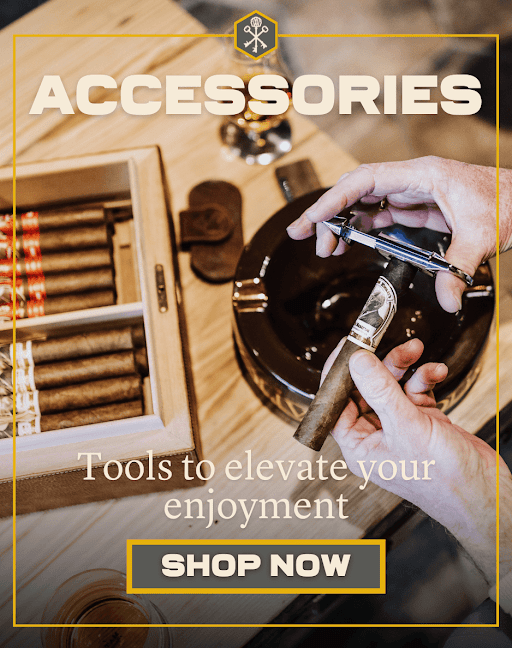Sharing the Heritage and Legacy of Pappy Van Winkle through our Collections & Partnerships:
Pappy & Company X Drew Estate, Premium Cigars
A Trip To Drew Estate in Nicaragua
In 2017 our entire family got to take an incredibly special trip to Nicaragua to visit our cigar partners, Drew Estate, who have been producing our Pappy Van Winkle Barrel-Fermented Cigars since 2014 as well as our Pappy Van Winkle Tradition Cigars. We were welcomed not only by the gorgeous country, but by the people, the workers and the long rooted traditions of cigar rolling.

Working with partners is an incredibly personal process. Especially for us, as we are literally putting our names, and our family’s legacy, behind it. So naturally we are very thorough and selective when it comes to who we work with and how and what we create. We wait for the natural partnerships to find us rather than forcing a collaboration in order to rush a product. Modeled after Pappy's own philosophies and strong convictions - he wasn't afraid of hard work, and believed there were no short cuts - things must be done properly, often the old fashioned, step-by-step way - as that was the only way to ensure the utmost quality of the finest product. He also instructed his associates, "if there is anything that even begins to look improper, get away from it, we don't want that business."
This is good advice, for life in general, and we have adopted that mindset and seek out partners who feel the same way. Organically, the most fulfilling and successful partnerships, both professionally and personally, have been those that have ended up turning our partners into lifelong friends. (Learn more about the partnership and how it reflects the heritage and legacy of Pappy Van Winkle here).

Our original experience in Nicaragua was incredible (learn more here) and I have wanted to find a way back since. When we planned a Spring Break trip to Nicaragua, I decided it was the perfect opportunity to include a side trip back to the factory, only this time, I could bring my 14 year old son along. It is a family business after all! The ability to offer this cultural experience for him, and two of his friends who accompanied us, was invaluable, and just another way that these partnerships have expanded in ways we couldn’t have imagined a few years ago.
To see firsthand the work and the culture around the cigar factory made such an impact and was a once in a lifetime experience that will resonate with them forever. It gave him an opportunity to see what I do in a different light, and to appreciate the dedication to our family’s legacy that he will hopefully one day be a part of as well.

His teachers were equally as excited - as he has attended a Spanish immersive school in Idaho, this was an opportunity to practice his Spanish speaking skills in a real life way. Giving them a different perspective to the culture, the work, ethic and the true legacy of the land before they became tourists soaking up the sun, the surf and of course, the cuisine!
Our first surprise was finding Willy Herrera on our flight to Managua. Willy is the master blender from Drew Estate, and we were thrilled for the extra time with him. We were greeted at the airport by our friend Harry from the factory, who must have known how to impress some 14 year old boys as he came bearing coolers full of soft drinks (and local beers for the adults) and pumped 90’s music on the way. We had a three hour trek ahead of us, a daunting prospect after a very long day of traveling, but we were instantly reinvigorated by the sustenance, music and camaraderie and absolutely fascinated by the sights and sounds of our journey.
This provided a true insider’s guide through the very winding roads of the country en-route to the factory as we wove in and out out of small communities along the way. The boys were especially fascinated by the traffic - much different than what we are used to - with buggies carted by mules along the sides of the road and the semi trucks who had bright neon lights because there are no street lights! Between the lack of sleep and the jet lag, it felt surreal - but was such an important way to immediately immerse ourselves.
We were staying at the Safari House, tucked within the gates of the Drew Estate factory in Estelí. Originally built to welcome guests to the factory, it often houses visiting employees, or partners of the brand, like us. Fernando greeted us, showed us around, and most importantly - led the hungry boys to a waiting array of tacos which were quickly and unceremoniously devoured! The pool and patio area is overlooking the beautiful Nicaraguan landscape and the town below and is where we spent most of our downtime, enjoying freshly prepared meals that celebrated the traditions and flavor of Nicaragua. Strong Nicaraguan coffee, fried fish, tortillas and lots and lots of gallo pinto (rice and beans) were enjoyed.

On our first morning of we were grateful for the strong coffee - as we had a very full schedule ahead of us. Our first stop was a local tobacco farm. A beautiful farm specializing in “shade grown tobacco” - the type typically use in the wrapper- which is the final step of the cigar rolling process that binds it all together. Although it was not a farm that supplied our tobacco, it was a perfect first stop to begin to take in and help the boys understand the amount of work and the attention to detail for every single ingredient that goes into making cigars is. Drew Estate is equally as meticulous as we are about partnering with farmers and growers who adhere to strict quality standards. Every ingredient matters and that begins with the seeds, the practices and the people behind it.

We also visited the curing barn on-site to witness the traditional process - very similar to the way cigars have always been made - where the tobacco is dried and the temperature is carefully observed via a thermometer on a pully that is pulled down from the roof of the barn many times per day, and the climate is modified based on the temperature by huge barn doors that are opened and closed. Next up was the fermentation warehouse where we were immediately greeted by the overwhelming scent of ammonia. The bundles of tobacco are strategically layered inpilones - this the technical term for a large pile of tobacco - and they can be enormous - weighing up to 4,000 pounds or more! Over time, the weight of the pile naturally begins the fermentation process.

After, we stopped at the storage warehouse where all of the tobacco is stored. We were able to discuss the difference between fermentation via pilones and our barrel-fermentation process, whereby we use bourbon barrels under 1000’s of tons of pressure to create fermented tobacco. This results in a much richer color, more pliable tobacco and a deeper flavor profile with recognizable traces of molasses and the smokiness from the fire curing process.

After a lunch break, where the boys immediately jumped in the pool and we enjoyed another delicious and traditional lunch overlooking the lush tropical surroundings - we were off to the grand finale of the day - the stop everyone had been looking forward to since we arrived - the main rolling room. This final part of the process is probably most recognizable to anyone regarding cigars, and we were all excited to see it close up and in action.
Walking in alongside Willy Herrera, we were immediately in awe, and can say we wholeheartedly agree with his sentiment, that "it never gets old, no matter how many times you see it." Similar to the sense you get when you visit a distillery and can truly understand just what goes into the bourbon making process. Entering the vast space was like walking into a living museum. The room is massive and loud, and overwhelming at first glance until you see that you are witnessing a well oiled machine at work.

Years of tradition, of old fashioned processes honed to perfection over generations, at work before our eyes. Each part of the system works individually in their own silo, yet together, the entire operation is part of a large system that works cohesively and beautifully. A perfectly choreographed dance where every role is defined and every dancer executes it to the minutest detail before handing the baton off to the next. Seeing it from this perspective and understanding how each cog in the wheel works together for the same result was incredible and such an amazing learning experience for our boys.

Witnessing this operation on this scale is truly incredible to behold and it marks an defining chapter in Drew Estate's history. One that started, similar to ours, on a small scale. Just as we were starting out in my sister’s basement, Jonathan Drew began this entire operation, one that we were now watching unfold in real time in an enormous warehouse in the middle of Nicaragua, from a kiosk at the World Trade Center. Where he sold cigars by day and his partner slept on a mattress in the small factory in Estelí by night.
The process was fascinating to observe, and the workers were incredibly kind and knowledgeable and happy to share their insight and thoughts with us as we walked though. A single cigar is rolled by a team of two people - a bunchero and a roller, typically male and female partners, with strict quality control measures. While their operation is vast, producing 4-5 million post-rolled units throughout the year, they maintain a very “old school” factory, according to Drew, who explains “as wild as we appear and as progressive as we are in innovation, everything is very traditional in production.”
The Bunchero were so welcoming and kind, and took the time to show us how to roll a cigar, even allowing each boy to roll one - putting their Spanish speaking skills to good use - it was an incredibly special moment to watch as the boys laughed and learned alongside someone so engulfed in their own craft and trade so outside of their typical everyday. We witnessed the rigorous quality control process up hand. There is an entire quality control department that inspects each brand each day Every 15 minutes a supervisor tests the cigars where every single stick is put through a draw and ring gauge test on the rolling floor. The same rollers work with the same brand, ensuring consistency and developing a brand expertise over time.
We visited the aging room, where depending on the blend, they are aged for a certain amount of time to achieve the ideal flavor profile. We were struck so many times about the similar nature of cigar making and bourbon aging, so many parallels between the delicacy of the process, the necessity to do things slowly and without shortcuts. Cigars and bourbon mirror each other in this way, as do the business practices between our two companies, and our promise to adhere to these old fashioned traditions. Seeing it in this way - it makes even more sense that bourbon and cigars are so tied to one another.

Admiring the process in person, we further appreciate how our Pappy Van Winkle Barrel Fermented cigars stand out - they are certainly the most intricate and complicated cigars to produce. Pieces of the barrel-fermented tobacco are woven into the entire process, it is used in the filler, and the wrapper, while another piece is perfectly cut out for the tip. Just another example of going above and beyond to provide the best possible smoking experience and overall flavor profile. From the darker, richer color of the barrel-fermented tobacco, to the detail oriented process, these cigars are truly works of art, yet remain approachable and highly enjoyable cigar to smoke. So many of Drew Estate's most ardent fans have even shared that they are their favorite cigars of all time - and especially after this trip, that sure says a lot!
We also got to stop by Sub Culture Studios, Drew Estate's in house art studio, that creates the art for the brands, as well as paint murals all over the factory walls that represent the brands they produce, in yet another nod to the vibrant cultural influence of Nicaragua on the cigar making process. They also create the marketing materials used to support their philanthropic partner, Cigars for Warriors. Bringing every aspect in-house allows Drew Estate the opportunity to provide apprenticeships and jobs, and create opportunities for movement and upward growth for their employees.
Supporting their local employees has long been a part of Drew Estate's motivation and business model. They provide on-site healthcare for employees and their families, free transportation to and from the factory from surrounding areas in Estelí, and even offer low interest loans for motorcycles and methods of transportation for work. Their appreciation for the local culture, and workforce is tangible in every aspect of how they have made a lasting impact on the cigar world. We continue to be so inspired by their dedication, their innovation and their passion.
Our final stop that day was dinner in town in Estelí. Not a traditional tourist destination, we were immersed instead in a true locals experience. It's a true working town, now invigorated and redefined as a cigar factory town, a relatively new element to the landscape of Nicaragua, which didn't rise to the popularity and recognition since really getting their start in the industry in the 1980's. Now the history and legacy of cigar making is fully enmeshed in the culture of this region, and now recognized for their tobacco farms and factories.

The next day we were treated to another local breakfast and strong coffee, and as we headed off to visit Granada, the oldest colonial town in Central America, we left with a deep appreciation for the people, the processes and the culture that are all a part of what make our cigars so uniquely special. Cigars and bourbon are made to be enjoyed. They are usually part of a beloved routine, a moment to slip away and relax, often times saved for special occasions or celebrations. Sometimes they are enjoyed at a certain time, or in a certain location, enjoyed with a treasured glass, or a favorite light. These are symbolic rituals, made all the more special with the full appreciation of the same level of ritual dedication behind their creation.
Working with Drew Estate is a reminder of the same values we inherited from our great-grandfather. A strong work ethic that is balanced by a true appreciation for life, moments of joy and celebrations. A promise of quality that is firmly held, with the understanding that is only achievable when the passion is real and shared, and the people and processes behind it are trusted, celebrated and honored. A knowledge that progression and innovation is only achievable when history and tradition are recognized and upheld, and of course that the best way to craft something worth while is to have fun while doing it.











